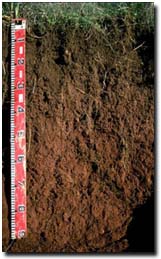Victorian State Soil Contender - Red Ferrosol

Back to: Contenders for State Soil
Why should the Red Ferrosol be Victoria’s State Soil?
- Red Ferrosols evoke: (a) warmth and well-being because of their strong red colour, (b) sensuality because of their feel, and (c) productivity because of the grand trees (e.g. Mountain Ash) and other plants, both native and introduced, that they support.
- Do you like potato chips, flowers, dairy products, good wine and beef? Would you like a soil in your backyard that is deep, well structured and friendly to till? Then the Red Ferrosol (also known as the ‘krasnozem’ using older soil classification terminology) is the soil for you.
- Ferrosols are associated with older volcanic landscapes. They are very deep and probably some of the oldest soils in Victoria and for that reason alone demand great respect.
- Ferrosols are highly prized for primary production. Land where the Red Ferrosols exist commands amongst the highest prices paid for land in Victoria because of the great value of these soils as a medium for growing plants. They are important cropping (potato, cut flowers etc) and dairy soils in West Gippsland where they are associated with rolling hills in the Warragul and Thorpdale regions. Other Ferrosols used for cropping (mainly potatoes) also occur in the Ballarat area. Smaller occurrences are west of Portland, Daylesford, far East Gippsland, Gembrook-Silvan, Kilmore and parts of King Valley in northeast Victoria where they support viticulture as well. In the Gembrook-Silvan area these soils support horticulture and cut flower production. Red Ferrosols are easy to manage because of their highly stable aggregates that segregate easily and resist deformation upon cultivation.
- Red Ferrosols are not an extensive soil in Victoria, occupying about 2% of the land area.
- Tasmania may well consider a Ferrosol to be their State Soil – as Tasmania has a greater proportion of Ferrosols than any other Australian state.
- Although Red Ferrosols are excellent cropping soils they still require careful management to maintain productivity. They have formed under conditions of good drainage and moderate to high rainfall and so leaching has led to strong acidity and deficiencies in some nutrients required to grow crops like potatoes. Also, active iron oxides tie up phosphorus and molybdenum in poorly available forms and so these nutrients can be deficient also. Appropriate fertiliser applications easily make good any deficiencies that may exist and lime can be used where necessary to correct for acidity. In spite of their natural physical stability, these soils may also suffer from physical degradation under exploitive regimes of management, a situation that can be avoided by less frequent cultivation, delaying cultivation until after rain or irrigation, maintaining soil organic matter levels, avoiding over-trafficking or over-cultivation when too wet, and generally by more sensitive management.
 Ferrosols in West Gippsland support horticulture and dairy production. |  Ferrosol near Leongatha |
Key features of the Red Ferrosol
- These soils display a gradual increase in texture (clay content) with depth. Surface soils are often clay loams that grade into light clays in the subsoil.
- These soils are relatively high in free iron oxide - giving them the distinctive red colour. The high iron levels can 'lock up' applied phosphorus but also contribute to this soil's well-developed soil structure. The structure is usually very fine (usually polyhedral), usually with smooth and often shiny faces. This well developed structure provides plenty of opportunity for water, air and root movement.
- They are usually moderately to strongly acid throughout - a product of their good porosity, high rainfall and long periods of leaching.
- Although these soils are considered to be well structured and attractive for agriculture, they can degrade under intensive cropping from erosion and compaction and may also suffer from acidification.
Typical soil profile
|  Ferrosol Site Profile near Leongatha |


